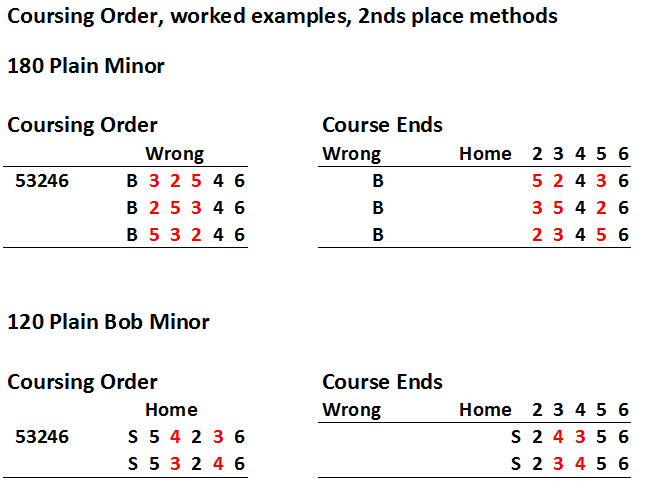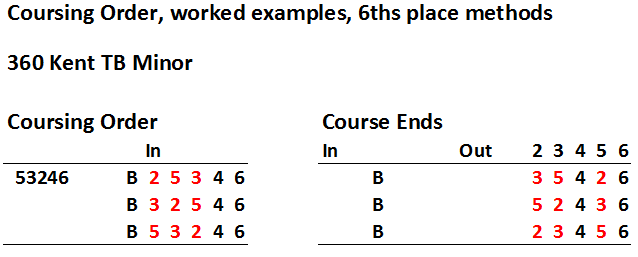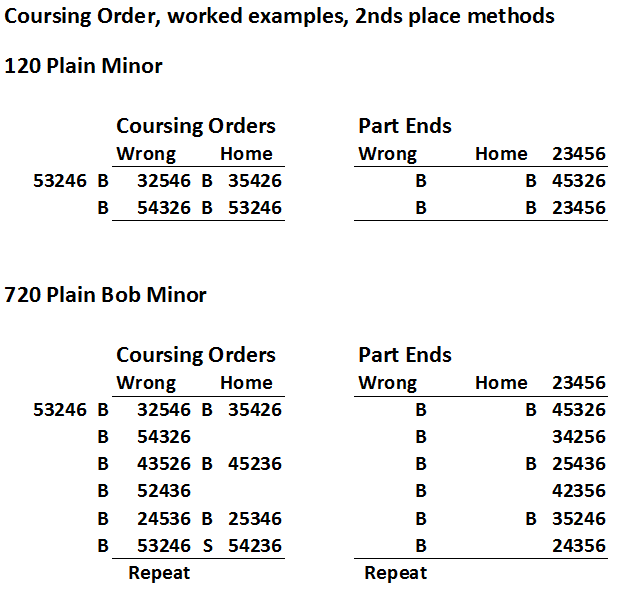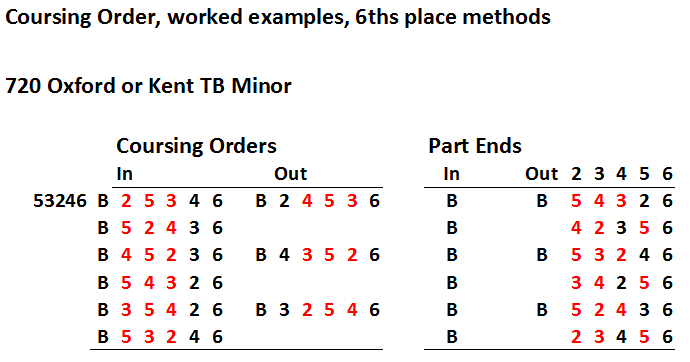Coursing Order
The concept of Coursing Order
The defined nature of bellringing methods leads to a defined relationship amongst the bells (both tower and hand), known as the "Coursing Order".
The relationship is fixed (although alowances need to be made for the hunt bell(s)), until a call is made.
The relationship, (coursing order) remains unchanged between calls.
The significance of Coursing Order
Ringing one towerbell, especially in simple methods like plain bob, the relationship with a course bell, and an after bell quickly becomes apparent.
That relationship is even more significant on handbells where a ringer is involved with more of the bells being rung.
The discussion on coursing order on this website is related to
regular
methods, i.e. where
natural coursing order
is preserved when the treble is leading.
Coursing Order in Plain Bob
In the plain course of Plain Bob Minor, the bells lead in the order:
2, 4, 6, 5, 3, 1, 3, 2, 4, 6, 5, 1, 5, 3, 2, 4, 6, 1, 6, 5, 3, 2, 4, 1, 4, 6, 5, 3, 2, 1.
Between each successive lead of the treble, the other 5 bells each have one turn at lead,
and whilst the last bell leading before the treble is the first to lead after the treble (because it makes seconds place),
the order in which the bells lead is always the same, 2, then 4, then 6, then 5, then 3.
2-4-6-5-3 is the coursing order.
In Plain Bob Maximus the coursing order is 2-4-6-8-0-T-E-9-7-5-3.
The bells lead, in turn, in that order.
The bells lie behind, in turn, in that order.
The treble passes the other bells when it hunts from lead to lie, in that order.
The treble passes the other bells when it hunts from lie to lead, in that order.
24653 is a correct expression of the coursing order for the plain course of regular methods but you will hear and see the sequence 53246 much more commonly.
One famous ringer even has 53246 embedded in his e-mail address.
Having Bell No 6 anchored at the end of the coursing order is an aid to conductors, where in minor 6 (tenor) is usually the
observation bell,
and it helps to have that bell in a fixed relationship with the other bells.
Coursing Order in more Complex Methods
In simple structure such as Plain Hunting and Plain Bob, awareness of these bells can be extremely helpful in navigating (at handbells speed) through a large number of bells.
Coursing order is still present in the more complex methods but may be harder to use as an aid to ringing.
Natural coursing order is preserved well in Cambridge Surprise above the Treble, in Norwich Surprise Minor, and in Yorkshire Surprise Major.
In more complex methods, the relationship between the bells is preserved in coursing order, but the bells may not be ringing as close together as they would be in Plain Bob.
E.g. Cambridge Surprise Minor at the first half lead, No 3 bells makes 5ths. The course bell for no 3 is 5, and the after bell is 2, this pair of bells is dodging together in 1-2 when 3 is making the 5ths place.
As the number of bells being rung is increased, so the number of bells maintaining a fixed relationship also increases.
That fixed relationship is an expression of the coursing order.
For example, in Plain Bob Major, it is very rare for bells 7 and 8, a.k.a. "The Tenors", to be parted for more than one lead.
In Plain Bob Royal, bells 7, 8, 9, and 10 often ring a whole peal without change to their relationship.
Coursing Order and the impact of Calls
Seconds Place methods
When a bob is called, three consecutive bells in the coursing order are affected.
Of those three bells, the first makes the bob, the second runs out, and the third runs in.
If before the bob, the bells are coursing in the order a-b-c, then after the bob they are coursing b-c-a.
When a single is called, three consecutive bells in the coursing order are affected.
Of those three bells, the first makes the 4ths for the single, the second makes seconds for the method out, and the third makes thirds for the single.
If before the bob, the bells are coursing in the order a-b-c, then after the bob they are coursing c-b-a.
So whilst the method work for "b" is unaffected, the single switches round its course bell and after bell.

Diagram: 1r.11.01 Coursing Order Example No 1.
Sixth Place minor methods
The tenor bell is still normally used as the observation bell, but using unaffected calling positions In and Out (of the slow work).
The method work of hunting in, hunting out and making the bob still apply to the coursing order, even though the affected bells make the bob and dodge in 5-6.

Diagram: 1r.11.02 Coursing Order Example No 2.
Keeping the tenor bell as the last number in the coursing order for the calls in the above example, means that the bell making the bob effectively jumps to the beginning of the block of 3 affected bells,
rather than to the end.
Coursing Order and Conducting
Minor Methods
When using the tenor as
observation bell
the natural coursing order is written 53246. Calls at
Wrong
affect the first three bells, and calls at
Home
affect the middle three bells.
Continuously following the coursing order during a touch is the primary tool that a conductor uses for assurance that bells are ringing correctly in line with the composition.
Worked examples

Diagram: 1r.11.03 Coursing Order Example No 3.

Diagram: 1r.11.04 Coursing Order Example No 4.
Developing skill in the use of Coursing Order
The skill of
transposing
coursing orders and checking that bells are correct can be practised silently and unknown to the rest of the band
whilst you are ringing and someone else is calling.
Once the skill of
transposing
coursing orders has been acquired, begin to observe the bells working in that coursing order, starting in Plain Bob.
For example:
- Observe the bells leading in coursing order
- Observe that the bells affected by calls do so in line with the coursing order
- Observe that the pair of bells hunting down after dodging together in 5-6 do so in coursing order
With patience and determination, a skilled ringer can develop the use of coursing order to the extent that all bells can be followed
continuously throughout the ringing.
Once a level of skill with Coursing Order in Plain Bob has been achieved, a ringer will wish to review more complex methods for the relevance of Coursing Order.
For example:
- In Kent TB Minor, note the order in which the Treble passes the other bells
- In Kent TB Minor, note how the Slow Bell relates to the Treble
- In Oxford TB Minor, note how the bell making places relate to the Slow Bell
- In London Surprise Minor note how the bells work in Natural Coursing Order at the Lead Ends
|

